Fama-French Five Factors Model pada Excess Return Saham Indeks Kompas 100
DOI:
https://doi.org/10.35838/jrap.2022.009.01.07Keywords:
Excess Return, Five Factor Model, Indeks Kompas 100Abstract
ABSTRACT
In accordance with the title of this study, namely Empirical Test of the Effect of the Fama-French Five Factor Model on Excess Returns on Stocks listed on the Kompas 100 Index for the 2015-2019 period, this study aims to partially re-test the Fama-France Five Factor Model method. This study uses return data from stocks listed on the Kompas 100 Index from January 2015 to December 2019 which are then formed into time series data with excess monthly stock portfolios. This study adapts the methodology of Fama and French (2015) using 2X2 and 2x3 constructions to form a portfolio and applying Ordinary Least Square (OLS) with monthly data frequencies to test the relevance of the model to the excess stock returns of 56 companies listed on the Kompas 100 Index. The results showed that Market Excess Return (MKT), the size of which was proxied by Small Minus Big (SMB), the book-to-market ratio proxied by High Minus Low (HML) had a significant positive effect on the Excess Return of the stock portfolio of companies listed on the Kompas 100 Index. , while Profitability proxied by RMW (Robust Minus Weak) has a significant negative effect on Excess Return, and Investment proxied by Conservative Minus Aggressive (CMA) does not affect the expected Excess Return of the stock.
ABSTRAK
Sesuai dengan judul dari penelitian ini yaitu Uji Empiris Pengaruh Fama-French Five Factor Model terhadap Excess Return pada Saham yang terdaftar di Indeks Kompas 100 periode 2015-2019 maka penelitian ini bertujuan untuk menguji kembali metode Fama-France Five Factor Model secara parsial. Penelitian ini menggunakan data return dari saham yang terdaftar di Indeks Kompas 100 mulai dari Januari 2015 sampai dengan Desember 2019 yang kemudian dibentuk menjadi data time series dengan kelebihan portofolio saham bulanan. Penelitian ini mengadaptasi metodologi Fama dan French (2015) menggunakan konstruksi 2X2 dan 2x3 untuk membentuk portofolio dan menerapkan Ordinary Least Square (OLS) dengan frekuensi data bulanan untuk menguji relevansi model terhadap Excess return saham dari 56 perusahaan yang terdaftar di Indesk Kompas 100. Hasil penelitian menunjukkan bahwa Market Excess Return (MKT), size yang diproksikan dengan Small Minus Big (SMB), rasio book-tomarket yang diproksikan dengan High Minus Low (HML) berpengaruh positif signifikan terhadap Excess Return portofolio saham perusahaan yang terdaftar di Indeks Kompas 100, sedangkan Profitability yang diproksikan dengan RMW (Robust Minus Weak) berpengaruh negatif signifikan terhadap Excess Return, dan Investment yang diproksikan dengan Conservative Minus Aggressive (CMA) tidak mempengaruhi Excess Return saham yang diharapkan.
Downloads
References
Acaravci1, Songul Kakilli, dan Yunus Karaomer2**. “Fama-French Five Factor Model: Evidence from Turkey*.” International Journal of Economics and Financial Issues, 2017: 130-137.
Chiah M, Chai D, Zhong A, Li S. “A Better Model? An Empirical Investigation of the Fama-French Five-Factor Model in Australia.” International Review of Finance, 2015.
Eduardus, Tendelilin. Portofolio dan Investasi Teori dan Aplikasi (Edisi pertama). Yogyakarta: Kanisius, 2010.
Eugene F. Fama a, Kenneth R.French. “A Five Factor Asset Pricing Model.” Journal of Financial Economics, Elsevier, 2015: 1-22.
Ghozali, Imam. “Analisis Multivariant dan Ekonometrika.” Dalam Analisis Multivariant dan Ekonometrika, oleh Dr. Dwi Hatmono Prof H. Imam Ghozali. Semarang: Universitas Diponegoro, 2013.
Harshitaa, Singh, S.a, Yadav, Surendra S.a. “Indian stock market and the asset pricing model.” Procedia Economics and Finance, Elsevier Journal. , 2015.
https://www.idnfinancials.com/. “Laporan Keuangan Perusahaan Tahunan.” 2014-2019.
https://www.idx.co.id/data-pasar/ringkasan-perdagangan/ringkasan-saham/. “Laporan Saham Beredar .” 2014-2019.
https://www.investing.com/. “Laporan Close Price Seluruh Saham Indeks Kompas 100.” Bulanan 2014-2019.
Huang, Tzu-Lun. “Is the Fama and French five-factor model robust in the Chinese stock market? .” Asia Pacific Management Review, Elsevier Journal., 2019.
Johnson, Gray and. “The relationship between asset growth and cross-section of stock returns.” Journal of Bangking and Finance, 2011: 670-680.
Marx, Novy. “The other side of value: The gross profitability premium.” Journal of Financial, 2013: 1-28.
Nisa, Aminatun. “Pengaruh Pemahaman Investasi, Modal minimal Investasi dan Motivasi Terhadap Minat Mahasiswa Berinvestasi di Pasar Modal.” Jurnal Penelitian Teori dan Terapan Akuntansi, 2017.
P., Jones C. Investment Principles and Concepts. Singapore: John Wiley and Sons Singapore Pte. Ltd., 2014.
Pondaag, Rianty Nikita Lotazia, dan Erni Ekawati. “Accounting Information In the Fama and French Three-Factors Model.” Jurnal Akuntansi dan Keuangan Indonesia, 2020: Volume 17 Nomor 2 hal 197-220.
Pte.Ltd., John Wiley and Sons Singapore. “Investment Principle and Concepts.” Dalam Investment Principle and Concepts, 22. Singapore, 2014.
rate/data/Default.aspx, http://www.bi.go.id/en/moneter/bi. “BI Rate.” 2014-2019.
Sudiyatno, irsad m. “Study of The Three Factor Model Fama and French in Indonesia Stock Exchage.” Jurnal Bisnis dan Ekonomi, 2011: 126-136.
Sutrisno, Bambang, dan Irwan Adi Ekaputra. “Uji Empiris Model Asset Pricing Lima Faktor Fama and French di Indonesia.” Jurnal Keuangan dan Perbankan, 2016: 343-357.
Tekehara, Kubota dan. “Does the Fama and French Five Factor Model Work Well in Japan?” International Review of Finance, 2017.
U'um Munawaroh, Sunarsih. “Pengaruh lima faktor Fama-French dan faktor momentum.” Jurnal Ekonomi dan Keuangan Islam, 2020: 119-133.
Vera Ch. O. Manoppo, Bernard Tewal, Arrazi Bin Hasan. “Pengaruh Current Ratio, DER, ROA dan NPM Terhadap Harga Saham pada Perusahaan Food And Beverages yang Terdaftar di BEI.” Jurnal Manajemen, 2017.
Downloads
Published
Issue
Section
License
Authors who publish with this journal agree to the following terms:
- Authors retain copyright and grant the journal right of first publication with the work simultaneously licensed under a Creative Commons Attribution-ShareAlike 4.0 International License that allows others to share the work with an acknowledgement of the works authorship and initial publication in this journal.
- Authors are able to enter into separate, additional contractual arrangements for the non-exclusive distribution of the journals published version of the work (e.g., post it to an institutional repository or publish it in a book), with an acknowledgement of its initial publication in this journal.
- Authors are permitted and encouraged to post their work online (e.g., in institutional repositories or on their website) prior to and during the submission process, as it can lead to productive exchanges, as well as earlier and greater citation of published work (See The Effect of Open Access).














